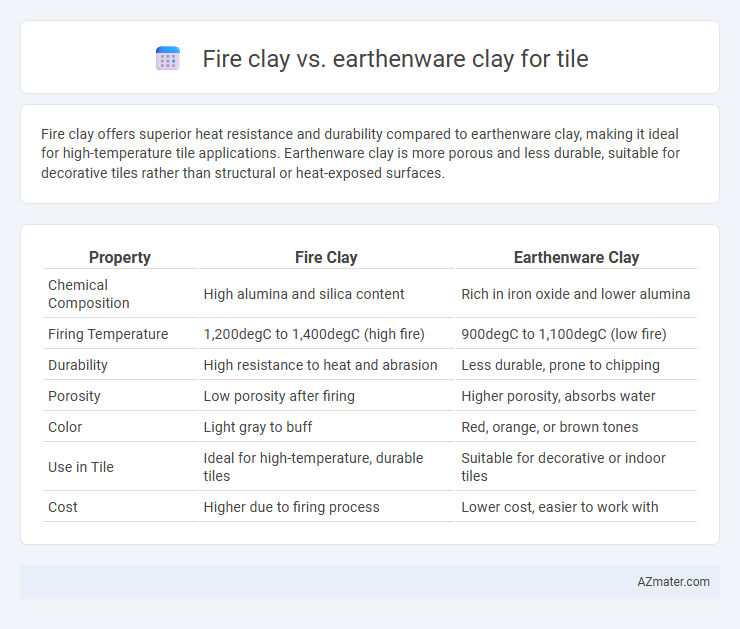Fire clay offers superior heat resistance and durability compared to earthenware clay, making it ideal for high-temperature tile applications. Earthenware clay is more porous and less durable, suitable for decorative tiles rather than structural or heat-exposed surfaces.
Table of Comparison
| Property | Fire Clay | Earthenware Clay |
|---|---|---|
| Chemical Composition | High alumina and silica content | Rich in iron oxide and lower alumina |
| Firing Temperature | 1,200degC to 1,400degC (high fire) | 900degC to 1,100degC (low fire) |
| Durability | High resistance to heat and abrasion | Less durable, prone to chipping |
| Porosity | Low porosity after firing | Higher porosity, absorbs water |
| Color | Light gray to buff | Red, orange, or brown tones |
| Use in Tile | Ideal for high-temperature, durable tiles | Suitable for decorative or indoor tiles |
| Cost | Higher due to firing process | Lower cost, easier to work with |
Understanding Fire Clay vs Earthenware Clay
Fire clay contains a higher percentage of refractory minerals such as kaolinite and alumina, providing superior heat resistance ideal for tile applications exposed to high temperatures. Earthenware clay has a lower firing temperature and is more porous, making it less durable and more suitable for decorative tiles rather than functional surfaces subjected to wear and moisture. Understanding these differences helps in selecting the appropriate clay type for tile manufacturing based on durability and thermal requirements.
Composition Differences
Fire clay contains higher amounts of alumina and silica, making it more refractory and suitable for high-temperature applications compared to earthenware clay. Earthenware clay typically has a higher content of impurities like iron oxide and fluxing agents, resulting in lower firing temperatures and more porous tiles. The compositional differences directly influence the durability, firing range, and finish quality of tiles made from each clay type.
Firing Temperature Comparison
Fire clay typically requires a higher firing temperature, ranging from 1200degC to 1400degC, resulting in a more durable and vitrified tile suitable for heavy-duty applications. Earthenware clay, on the other hand, fires at a lower temperature between 1000degC and 1150degC, producing more porous and less dense tiles ideal for decorative use. This temperature difference significantly affects the tile's strength, water absorption, and overall suitability for various environments.
Color and Texture Variations
Fire clay offers a dense, fine-grained texture with muted earth tones, including shades of brown, red, and gray, providing rich natural color variations ideal for rustic tile designs. Earthenware clay, by contrast, displays a more porous texture and a brighter color palette, ranging from creamy whites to deep terracottas, allowing for vibrant and varied tile finishes. The choice between fire clay and earthenware clay impacts the tile's visual appeal, with fire clay lending a more subdued, tactile surface and earthenware enabling diverse glazing options for vivid coloration.
Strength and Durability
Fire clay exhibits superior strength and durability compared to earthenware clay, making it ideal for tile applications requiring high resistance to wear and thermal shock. The dense, refractory nature of fire clay allows tiles to withstand heavy loads and extreme temperature changes without cracking or deforming. Earthenware clay, while more porous and less robust, is better suited for decorative tiles in low-stress environments due to its lower firing temperature and susceptibility to chipping.
Water Absorption Rates
Fire clay tiles have significantly lower water absorption rates, typically less than 3%, making them highly durable and resistant to moisture damage. Earthenware clay tiles generally exhibit higher absorption rates, often between 5-20%, which can lead to increased susceptibility to water-related issues such as cracking or efflorescence. Choosing fire clay over earthenware is advantageous for applications in high-moisture environments due to its enhanced water resistance.
Workability and Handling
Fire clay offers superior workability and handling compared to earthenware clay due to its higher plasticity and finer particle size, making it easier to shape intricate tile designs. Earthenware clay tends to be softer and more porous, which can lead to greater deformation during handling but provides a smooth surface finish ideal for decorative tiles. Both clays require careful moisture control, but fire clay's resistance to cracking under pressure makes it more durable for tile production.
Suitability for Tile Applications
Fire clay offers superior durability and thermal resistance, making it highly suitable for tile applications exposed to high temperatures or heavy wear. Earthenware clay, while easier to shape and less expensive, lacks the strength and thermal stability required for long-lasting tiles in demanding environments. Tiles made from fire clay exhibit better resistance to cracking and moisture absorption, ensuring enhanced performance and longevity in both indoor and outdoor settings.
Cost and Availability
Fire clay typically costs more than earthenware clay due to its higher firing temperature and durability, making it a preferred choice for specialized tile projects. Earthenware clay is more widely available and budget-friendly, ideal for decorative or low-traffic tile applications. Availability of fire clay can be limited regionally, whereas earthenware clay is more commonly stocked by ceramic suppliers worldwide.
Best Use Cases for Each Clay Type
Fire clay offers superior heat resistance and durability, making it ideal for creating tiles exposed to high temperatures such as kiln linings, fireplaces, and industrial settings. Earthenware clay, known for its porous nature and lower firing temperature, is best suited for decorative tiles, indoor wall installations, and areas with less thermal stress. Selecting fire clay ensures longevity in heat-intensive environments, while earthenware clay provides aesthetic appeal and ease of work for artistic or low-heat applications.

Infographic: Fire clay vs Earthenware clay for Tile
 azmater.com
azmater.com